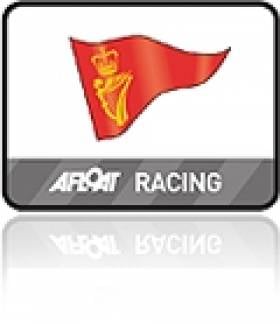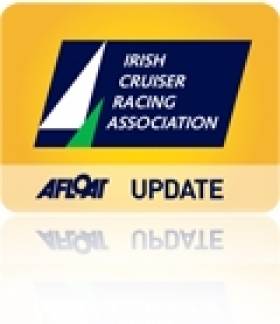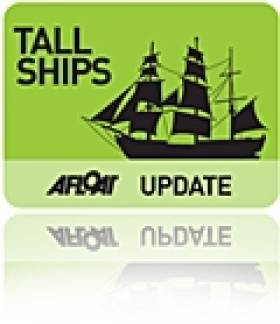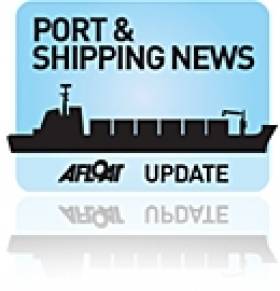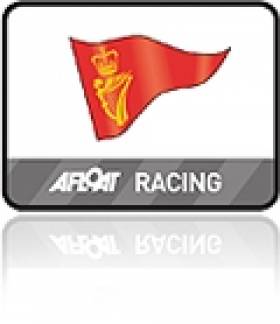Displaying items by tag: Cork Harbour
Tingle's 'Alpaca' Wins Class Two of Union Chandlery League
There were concentrated faces last night in Cork Harbour where the Royal Cork fleet had a windy evening of racing in the Union Chandlery June League.
Brian Heffernan's Dufour 365 Aisling was first in the in White Sail division. Class 3 went to Jimmy Nyhan and Maritta Buwalda in their Quarter Tonner Outrigger. Class 2 winners were Paul and Deirdre Tingle's First 31.7 "Alpaca" and in Class one the honours went to Robert O'Leary in his modified 1720 Antix Beag.
Concentration this morning now turns to the first race of the ICRA National Championships being held in Crosshaven.
The wind was southwesterly at about 20 knots gusting to 30. Race officers set an excellent course (No.70). It was a clean start at the top of the tide, with a beat to the cage.
Those that kept to the south made the right call. It was then a run to No.7 where we gybed and headed for No.13 Some were brave enough to carry spinnakers with some interesting results both good and not so good. A number of Irish Naval ships at anchor off Spike Island.
After No.13 the fleet had a fetch back to No.9 and then a beat back to Cage. With the tide now ebbing it paid to go down the middle. We rounded Cage once again with a run back to No.7 more spinnakers up this time. After rounding No.7 the fleet had a nice beat home.
Ferry Operator Assists in Marine-Life Conservation Role
Fastnet Line which runs the Cork-Swansea port route on the Celtic Sea, is assisting the charity MarineLife to monitor cetaceans, writes Jehan Ashmore.
The work of MarineLife is to survey the population trends and track the movements of dolphins, whales, porpoises and other wildlife. The research is undertaken onboard Fastnet Line's Julia (1981/21,699grt) and access to the ferry is provided free-of-charge to the wildlife-based charity.
During the months of July and August the ferry's schedule will allow for further opportunities to conduct daylight sightings of marine-life which is to be posted on MarineLife and Fastnet Line websites.
Adrian Shephard, Chairman of MarineLife Trustees, said: "The route from Swansea to Cork crosses a range of marine habitats and we hope it will generate many sightings of cetaceans and seabirds, including two important species we monitor, the white-beaked dolphin and the balearic shearwater".
In addition monitors recently observed fin whales, the second largest whale on the planet. Such sightings provide vital information and this will contribute to a better understanding of the distribution of cetaceans and other marine life in the Celtic Sea. To read more www.marine-life.org.uk
The first of four summertime surveys is to take place on 10 July. Overall the research by MarineLife is part of a larger project which also involves the use of other ferries operating in the Irish Sea and those serving on UK continental routes.
The 1,500 passenger / 325 car-carrying Julia sails year-round six times a week between September to June and from next month and during August the vessel will provide eight sailings per week. For fares and sailings schedules contact www.fastnetline.com
A Weekend to Explore the 'Bounty'
The Cork-berthed replica HMS Bounty, the purpose built movie prop tallship used in the 1962 MGM studies film release of 'Mutiny and the Bounty' starring Marlon Brando, will be open to visitors from tomorrow, writes Jehan Ashmore.
The famous tall ship is to open to the public between (11am-6pm) and these times also apply to the Saturday and Sunday. Tours on board the Bounty are self-guided with crew assistance. Admission charges are €10 for adults and children €5, children under four years go free.
The Bounty is berthed at Albert Quay which faces opposite the Cork City Marina on the south quays of the city-centre.
The public can explore her "tween" deck 8' foot ceilings, this made it easier for the film crew and their equipment to access.
As a result, Bounty has been hired by filmcrews for the making of 'Treasure Island', 'Yellowbeard', 'Sponge Bob, Square Pants, the Movie' and 'Pirates of the Caribbean - Dead Man's Chest'. In addition to commercial movies, Bounty has also been the stage for many documentaries.
To compare the differences between the replica and the original 18th century built 'Bounty' click HERE.
Windy Start Expected for Friday's ICRA Nationals
In Class 0 Local boats Antix, Anthony O'Leary; Jump Juice, Conor Phelan and Gloves off Kieran Twomey will be challenged By George Sisk's new Wow, Norbert Reilly's Crazy Horse and Richard Fides Welsh entry Impetuous which is a former Blondie.
Class 1 sees a fine Class where last years Echo winner Ian Nagle's Jelly Baby will be challenged by sister ship Peter Reddin's Jetstream Denis Hewitt and friends on Raptor and likes of Donal O Leary's D Tox.
Class 2 will see a battle between Corby 25s; Vinny O' Shea's Yanks and Franks, Brian Goggin's new Allure and Denis Coleman's Thunderbird.These will be tested by likes of Conor Rohan's Ruthless, Shane Statham's Slack Alice Kieran and Liz O Brien's Magnet and Desmond Ivers Deasy combo on Bad Company.
Class 3 has a backbone this year of state of the art Quarter Tonners. ICRA are welcoming Black Fun Jamie Mc Dowell all the way from New Zealand where he will be challenged by Neil Kenefick's Tiger, Eamon Rohan's Anchor Challenge who will be up against Leonard Donnery's No Knomes, John Twomey's Blazer 23 Shilelagh and Sullivan Brothers in Running Wild. Fergus Coughlan's White Knight from Cobh will also challenge.

New Zealand yacht Black Fun, complete with torpodeo keel, has arrived in Crosshaven for Friday's Cruiser National Championships. Photo: Bob Bateman
First time Class 4 will see Kevin O Connor's Gaelic Kiwi take on likes of Alan Carroll's Sundancer and Michael Sexton' Granny Knot.
The Non Spinnaker Corinthian Cup sees a fine fleet where Billy and Hilary Duane's Expression will compete against Clive Doherty's Phaeton Bill O Mahony's Julia B and Seamus Gilroy's Split Point.
John Downing's Samba and Conor O Donovan's Extension will also be in contention.
Day Prize Sponsors Dubarry have come up with the innovative idea that each crew on the winning boats in IRC and Echo each day will receive a prize in reward for their efforts.Two styles of Dubarry sailing hats and custom sailing socks will be included in this effort to recognise crews and offer variety each day.
The Royal Cork have laid on high standard racing on the water under Race Officers Peter Crowley and Richard Leonard and crews will be warmly welcomed ashore to a carnival type atmosphere with music and casual food on the go immediately after racing.
Mansfield Returns to 1720s With a Title Win
After a break of five years, former class European champion Mark Mansfield returned to the 1720 class at the weekend and won the CH Marine sponsored national championships in Cork Harbour from a fleet of 14 boats.
The last race of the eight race championship decided the winner between Anthony O'Leary and Mansfield. In a fleet packed with previous owners the fleet also had all three helms from the winning 2010 Commodores' cup team sailing. Andrew Creighton was steering Aquatack, Nicholas O'Leary was steering T bone and Anthony O'Leary steering his own boat.
Although the sailing in 8-12 knots went according to plan a number of support boats were damaged in an incident unrelated to the racing.
Mansfield and his crew of Terry English, Mike Budd, Dave Meagher and Joe Bruen won half of the eight races and discarded a fourth to take the national title. Second overall was Anthony O'Leary and third Nicholas O'Leary.
The class hope that more crews can be attracted in to the sportsboat and the resurgence of the class in Cork Harbour continues.
Brando’s ‘Bounty’ Bound for Bloomsday
The tallship used in the 1962 film of 'Mutiny and the Bounty' starring Hollywood screen legend Marlon Brando is to make a Bloomsday arrival to the rebel city, writes Jehan Ashmore.
H.M.S. Bounty is a replica of the ship in the famous 1789 mutiny against Captain William Bligh. The tallship is to dock at Albert Quay in Cork city-centre and will be made open to the public on Friday 17th, Saturday 18th and Sunday 19th June (daily between 11am – 6pm).
Tours on board the Bounty are self-guided with crew assistance and the admission charge is €10 for adults and children €5, children under four years go free.
In recent years the Bounty has appeared in 'Pirates of the Caribbean II' and in the Lone Wolf Production Group documentary on 'Blackbeard'. The ship also appeared in 2003 for a documentary on Captain Bligh for the History Channel, and the Sponge Bob Square Pants movie, which was released in November 2004. Also in that year the tallship was used in an episode for MTV.
For more information about the Cork visit click HERE and for the Bounty's voyages and background, visit www.tallshipbounty.org
US Training-Ship Heads for Cork
For five-days the US training-ship State of Maine will make Cork Harbour her port of call, when the 16,000 tonnes vessel docks this evening, writes Jehan Ashmore.
The 500-foot long ship is on a 55-day training cruise that started late last month from her homeport of Castine Harbour in Maine. Since then the Maine Maritime Academy's training-ship has visited Norfolk, Virginia before crossing the Atlantic to include calls to Valetta, Malta and the vessel's most recent port of call was Civitavecchia in Italy.
Onboard the former oceanographic vessel that served in the US Navy as the USNS Tanner, there are students, officers and crew. The Maine Maritime Academy purchased the vessel in 1997 and she was converted to accommodate the training needs of the college.
The academy was founded in 1941 and enrolls more than 900 students from 35 states and from several foreign countries. Students in the college are awarded A.S., B.S., and M.S. degrees in 15 fields of study.
State of Maine is to berth at the Cobh Cruise Terminal, the facility which normally caters for cruiseships is to be followed by another training-ship the 17,000 tonnes Empire State on 22 June.
Doyle's Endgame Produces Results in Royal Cork Wine Race
A ding dong sailing battle for line honours between an A35 design and an X362 made up for last night's poor turnout at Royal Cork's Short handed Wine Race sponsored by Karwig.
Frank Doyle's Endgame (A35) beat Derry Good's X362 Sport Exhale on IRC Handicap in a tightly raced affair over a Cork Harbour course.
With a blustery westerley and a biting wind for this time of year it was only the hardy took to the water. Those that did had a great night of racing and entertainment. With a start from the committee boat at the grassy competitors got off on a run heading for Corkbeg before rounding to beat back to No. 8.
As usual, this was a choice of going left or right with the flood tide and from Corkbeg a reach to No. 10 where your photographic scribe was waiting in eager anticipation of the colours that were going to spring at him. However, it was not to be and perhaps they made a wise choice.
From No. 9 they reached back to Corkbeg with a fetch to finish at the beautifully refurbished Adrielle with Rory Fitzpatrick doing the honours as Race Officer.
After an exhilirating race the prospect of the warm clubhouse awaiting the competitors was very enticing and paricularly so in view of the generous wine prizes which were presented to every competing boat.
Rear Admiral Ronan Enright presented the prizes and paid due tribute and thanks to the generous sponsorship of locally based Karwig Wine Suppliers.
Results below.
Royal Cork now turns its attention to the 1720 Sportsboat Nationals running this Thursday to Saturday. 15 boats are expected. On Sunday the Examiner newspaper sponsored Round Spike Island race is also being staged.
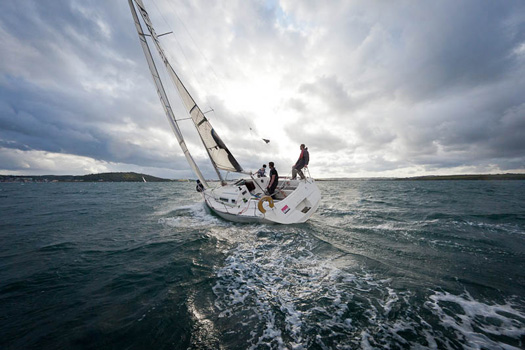
Action from last night's Shorthanded Wine Race. Photo: Bob Bateman. More photos below.
Shorthanded Wine Race:
Results IRC 1 Endgame 2, Magnet MG335 Kieran and Liz O'Brien 3, Wicket Sunfast 3 Mark Mendell.
Results Echo All In. 1 Silk Breeze Dehler 36 Ernie Dillon, 2 Exhale X362 Sport Derry Good, 3 Thistle Hustler 25.5 Peter Webster.
The conditions were ideal with a 7–knot breeze coming from the S.E. with flat water, blue skies and at the top of the tide. The harbour was looking its best.
The Race Officer set an excellent course. A bit of bias on the line made the start a bit interesting though. Class One got away clean. But Classes two and three had a General Recall.
After the start at Grassy the fleet had a beat out to No.3 The usual debate ensued over which side of the course was favoured. It was a close call in the end. Around No. 3 to starboard, spinnaker up and back to the Cage Bouy. A gybe and then on to No.12 at this stage there was a nice bit of ebb in the tide. It really was a case off keeping the Spinny flying for as long as possible up to the Mark. A nice beat followed, down to Corkbeg and then a nice reach back to the Grassy where the S flag was flying.
It was a good night for Billy Duane in his Sunlight 30 Expression in the White Sail fleet and for Jimmy Nyhan and Maritta Buwalda in their 1/4 Tonner Outrigger in Class 3.
First places also went to Thunderbird a Corby 25 owned by Denis Coleman in Class 2 and Endgame an A35 owned by Frank Doyle in Class 1.
GardaI Investigate U-boat Looting in Cork
Cork gardaí are investigating the looting of items from a First World War U-boat recently discovered off Roches Point.
The Irish Times reports that the submarine also appears to have been damaged by the illegal salvagers.
A spokesperson for the underwater archaeology unit of the Department of Arts, Heritage and the Gaeltacht confirmed that reports had come in from divers regarding disturbance of the wreck site - noting attempts to remove parts of the structure, and details of human remains.
Divers with the unit were expected to assess the site as soon as weather permits.
Items believed to have been taken include sailor's attire belonging to the crew of the 49-metre German vessel UC-42, which sank in 1917. The German embassy has indicated its "legitimate interest" in the preservation of the wreck.
The Irish Times has more on the story HERE.


























